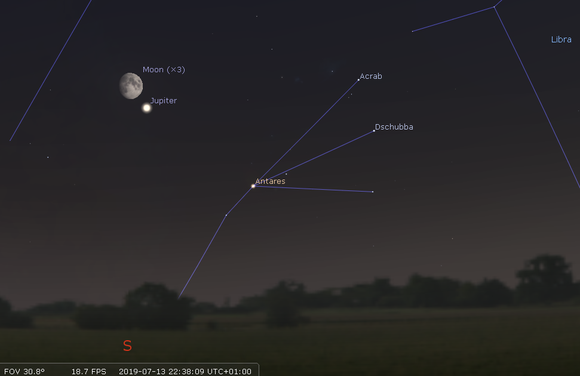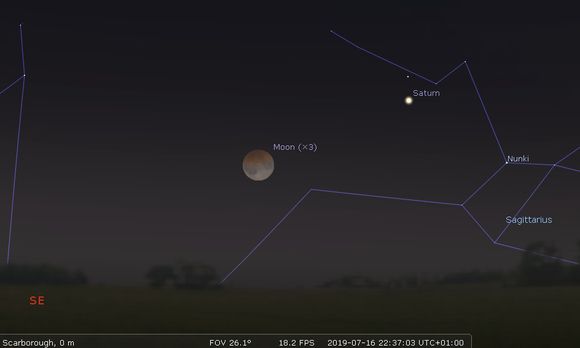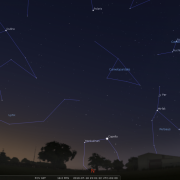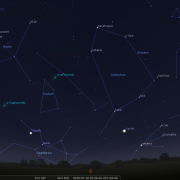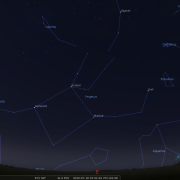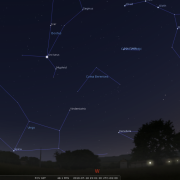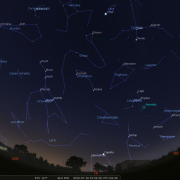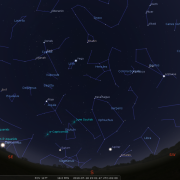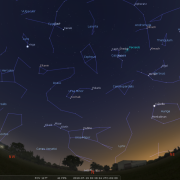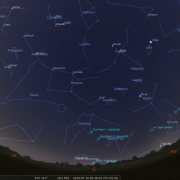In this month's Sky Notes:
Planetary Skylights
 Earth reaches aphelion (furthest from Sun) on July 4th, when it lies at a distance of 95 million miles or 152 million km.
Earth reaches aphelion (furthest from Sun) on July 4th, when it lies at a distance of 95 million miles or 152 million km.

Two planets dominate the July night sky- and they happen to be the two largest planets in the solar system; Jupiter and Saturn. Having reached opposition last month, Jupiter is visible as soon as skies become dark enough and at mag -2.6 is by far the brightest point in the sky. Look for it across in the SE as dusk falls not too far above the horizon. Jupiter currently resides in the southern most reaches of Ophuichus, which crosses the ecliptic and as such is going to be visible low in British summer skies. Observations require patience, but when seeing is steady, the view through the eyepiece is worth the wait with plenty of interest to follow.
Residing on the south equatorial belt is the huge ‘storm like’ feature known as the great red spot, a feature which in the last few decades has shrunk by almost a third, but still dwarf’s Earth in size. Because of the rapid rotation of Jupiter (10hrs approx) it is not always on view, (see times and dates). When facing Earth, the GRS resembles a subtle pale oval.
The most dynamic aspect of the Jovian system, the four Galilean moons, certainly warrants attention, with an ever changing configuration noticeable even over the course of a few hours.
On July 26th Jupiter resides close by the deep sky object NGC 6235, a magnitude 9 globular cluster some 37,000 light years distant, whilst Jupiter and its moons will be just 424 million miles (682 million km) away. The two objects will fit within the same eyepiece field, a fascinating view, given the huge distance gap between them.
Galilean moon shadow transits
Io on the following dates:
- 6th: 22:00h–midnight
- 14th: midnight–02:00h
- 22nd: from 22:00h
- 29th: 22:15h–midnight.
Europa:
- 2nd: 22:00h–23:30h
- 8th: midnight–02:00h.
Ganymede:
- 10th 22:00h–midnight
- 17th: 22:00h to post midnight
- 18th: 01:00h.
The Great Red Spot is visible on Jupiter’s disk on the following dates:
- 1st: 23:00h–02:00h
- 4th: 01:00h onwards
- 5th: 22:30h onwards
- 7th: 22:00h–01:00h
- 8th: 22:00h–02:00h
- 10th: 22:00h–midnight
- 12th: 22:00h–midnight
- 17th: 22:00h–midnight
- 19th: from 22:00h
- 21st: midnight
- 22nd: from 22:00h
- 24th: from 21:30h
- 26th: from 23:00h
- 27th: until 22:00h
- 29th: 21:00–23:00h
- 31st: 21:00h until midnight.
 The Moon lies nearby Jupiter in the sky on the 13th
The Moon lies nearby Jupiter in the sky on the 13th
 Saturn reaches opposition on the 9th and is therefore visible throughout the short hours of semi darkness experienced during the early summer months. Following in Jupiter’s wake by a few hours, Saturn will be on show low in the SE by 22:30h by the start of July, arcing low across the south over the course of the night. After Jupiter, Saturn is the next brightest planet currently visible at mag +0.1 and so is quite prominent.
Saturn reaches opposition on the 9th and is therefore visible throughout the short hours of semi darkness experienced during the early summer months. Following in Jupiter’s wake by a few hours, Saturn will be on show low in the SE by 22:30h by the start of July, arcing low across the south over the course of the night. After Jupiter, Saturn is the next brightest planet currently visible at mag +0.1 and so is quite prominent.
Residing in Sagittarius, just behind the ‘teapot’ asterism, Saturn suffers from the same disadvantages as Jupiter, ie. low altitude and unsteady seeing. Observations are therefore going to be somewhat compromised, but during moments of clarity Saturn is still a wonderful sight. The rings are still well orientated, with the two main ones; ring A and ring B, separated by the Cassini division. The dark inner ring (C) will be more difficult to make out, especially with Saturn being located low down.
If you have a pair of larger binoculars, or any telescope, look for Saturn’s largest moon; Titan, visible as a speck of light nearby. On July 3rd and 19th, Titan lies to the east of Saturn, and to the West it on 11th and 27th. Our Moon lies in proximity to Saturn in the sky on the 15th.
16-Jul-2019 at 23:30h (Looking South-East): Saturn and The Moon in Partial Eclipse.
(Click for full-sized image.)
Partial Lunar Eclipse
We have another lunar eclipse to look forward to in July (let’s hope we have better luck than the lunar eclipse last July – when in it rained down fire and brimstone during the evening)
The forthcoming eclipse on the 16th /17th is a partial umbral eclipse and will be already underway as the moon rises. The initial stages of the eclipse, first and second contacts, take place before the moon actually rises, when the moon moves into Earth’s penumbral shadow, becoming totally immersed in this lighter shadow. Things get interesting as the moon slides into the deeper umbral shadow shortly after 21:00h, with the moon rising around 21:30h already in this phase.
Mid eclipse occurs around 22:30h, by which time approximately 56% of the moon will be in umbral shadow. Forth contact arrives at midnight, when the moon leaves the umbral shadow and finally the penumbral phase ends at 01:20h when the whole eclipse is over. Although not total, it should nevertheless be an interesting eclipse, and will no doubt attract considerable public attention if the weather plays ball. We shall be holding a lunar eclipse party on the evening from the usual location of the Cook headland setting up shortly after 21:00h.
Meteors

A number of lesser meteor showers occur during July. The Capri-Cornids have 3 maxima, July 8, 15, and 26, all with zenith hourly rates (ZHR) of less than 10, barely more than sporadic rates. Moon light will washout the middle date, but not interfere with the other dates. Early morning hours will offer the best chance of catching a few shooting stars.
The Alpha Cygnids peak on July 21st, but again rates are barely more than sporadic levels. Cygnus is well placed high in the SSE by midnight. Moon light will interfere until after midnight.
The Delta-Aquarids are a little more prolific, peaking on July 30th with a ZHR of around 15. As always post-midnight observations will offer the best chance spotting any meteors.
July 2019 Sky Charts
|
Looking North
Mid-July - 23:00h |
Looking South |
|
Looking East
Mid-July - 23:00h |
Looking West
Mid-July - 23:00h |
|
Northern Aspect
Mid-July - 23:00h |
Southern Aspect
Mid-July - 23:00h |
| Looking North (Early) Mid-July - 03:30h |
Looking South (Early) Mid-July - 03:30h |
Additional Image Credits:
- Planets and Comets where not otherwise mentioned: NASA
- Sky Charts: Stellarium Software
- Log in to post comments

